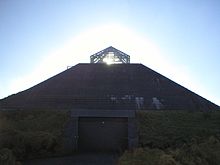Archaeological site in Ireland

The Céide Fields (Irish: Achaidh Chéide, meaning 'flat topped hill fields') is an archaeological site on the north County Mayo coast in the west of Ireland, about 4.3 mi (6.9 km) northwest of Ballycastle. The site has been described as the most extensive Neolithic site in Ireland and is claimed to contain the oldest known field systems globally. Using various dating methods, it has been stated that the creation and development of the Céide Fields went back approximately 5500 years (~3500 BCE), some 2,500 years before this type of field system developed everywhere else in Europe. Other dating methods and research has suggested that the complex developed 3,000 years ago, and is otherwise a "textbook example" of a Celtic field system, several examples of which are associated with late Bronze Age and Iron Age Europe. The Behy court tomb, a megalithic monument, lies within the Céide Fields complex.
The site is in UNESCO's tentative list to gain World Heritage status. There is estimated to be more than 100 km (62 mi) of field enclosure stone walls hidden beneath the peat bog.
History
The discovery of the Céide Fields originally began in the 1930s when a schoolteacher, Patrick Caulfield, noticed linear piles of rocks which were uncovered as he cut away some peat for fuel. Caulfield noted that the rocks must have been placed there by people, because their configuration was apparently unnatural and deliberate. The rocks were also positioned beneath the bog, which suggested they were there before the bog developed, implying a very ancient origin.
The unravelling of the significance of this discovery did not begin for another forty years when Patrick's son, Seamus, having studied archaeology, began to investigate further. Investigations revealed a complex of fields, houses and megalithic tombs concealed by the growth of blanket bogs over the course of many centuries.
While research by Caulfield and other archaeologists has dated the Céide Fields complex to the Neolithic (Stone Age) period, other research has questioned this conclusion and suggested a later (Bronze Age) date.
Research and preservation

In order to preserve the site and ensure the continuation of research, a simple method was used to explore the sub-bog walls. This involved the location and mapping of these hidden walls by probing with long T-shaped iron rods. (These were locally available as they were traditionally used to probe for prehistoric fallen timber below the bog.) The ensuing excavation of habitation sites and tombs revealed the way of life of people living 200 generations earlier. They were a community of farmers who cleared large areas of forest for use as farm land. Their main economy was cattle rearing but among them were also craftspeople and builders in both wood and stone.
It was discovered that these people arrived in a land with substantial forest cover. This was cleared to provide access to arable land and to provide building material and firewood. Palaeoecological research published in 1995 and 2001 indicated that the woodland cleared by the farmers was primarily pine and birch, and was cleared to create pasture for livestock. This clearance continued onward and outward away from the area in continuing procurement of firewood.

The climate at the time was much warmer, leading to almost year-round growth potential. Samples taken from the remains of trees found in the bog provided evidence of this.
For a while, these people prospered, but some changes led to the development of raised bogs and the transformation of the arable land into barren and unusable land. An ironpan has developed in the subsoil over the area of the Céide Fields.
Seamus Caulfied has estimated that there is more than 100 km (62 mi) of stone wall hidden beneath the bog.
See also
References
- "Achaidh Chéide". logainm.ie. Placenames Database of Ireland. Retrieved 10 September 2010.
- "A Pompeii in Slow Motion". The New York Times. 8 July 2001. Retrieved 10 September 2010.
- "Céide Fields". Heritage Ireland. Office of Public Works. Retrieved 7 September 2021.
The stone-walled fields, extending over hundreds of hectares, are the oldest known globally, dating back almost 6,000 years
- ^ "Céide Fields Visitor Centre". Museums of Mayo. Archived from the original on 22 July 2011. Retrieved 3 February 2009.
- ^ Whitefield, Andrew (2017). "Neolithic 'Celtic' Fields? A Reinterpretation of the Chronological Evidence from Céide Fields in North-western Ireland". European Journal of Archaeology. 20 (2): 257–279. doi:10.1017/eaa.2016.5. hdl:10379/16071. S2CID 165114322.
- ^ "The Céide Fields and North West Mayo Boglands". whc.unesco.org. UNESCO. Retrieved 7 September 2021.
- ^ "The Céide Fields: a Mayo miracle older than the pyramids". irishtimes.com. Irish Times. 5 August 2017. Retrieved 7 September 2021.
- "History of Céide Fields". Museums of Mayo. Archived from the original on 28 May 2007. Retrieved 25 February 2007.
- Caulfield, Seamus; O'Donnell, R. G.; Mitchell, P. I. (1998). "14C Dating of a Neolithic Field System at Céide Fields, County Mayo, Ireland". Radiocarbon. 40 (2): 629–640. doi:10.1017/S0033822200018567. Retrieved 8 September 2021.
- Verrill, Lucy; Tipping, Richard (2010). "A palynological and geoarchaeological investigation into Bronze Age farming at Belderg Beg, Co. Mayo, Ireland". Journal of Archaeological Science. 37 (6): 1214–1225. doi:10.1016/j.jas.2009.12.020. Retrieved 7 September 2021.
- Molloy, K; O'Connell, M (1995). "Palaeoecological Investigations towards the Reconstruction of Environment and Land-use Changes during Prehistory at Céide Fields, Western Ireland" (PDF). Probleme der Küstenforschung im südlichen Nordseegebiet (23): 187–225.
- O'Connell, M; Molloy, K (2001). "Farming and Woodland Dynamics in Ireland during the Neolithic". Biology and Environment: Proceedings of the Royal Irish Academy. 101B (101B). Proceedings of the Royal Irish Academy: 99–128. JSTOR 20500109.
- "BBC Two - A History of Ancient Britain, Series 1, Age of Ancestors". BBC.
External links
54°18′18″N 9°27′25″W / 54.30500°N 9.45694°W / 54.30500; -9.45694 (Céide Fields)
Categories: